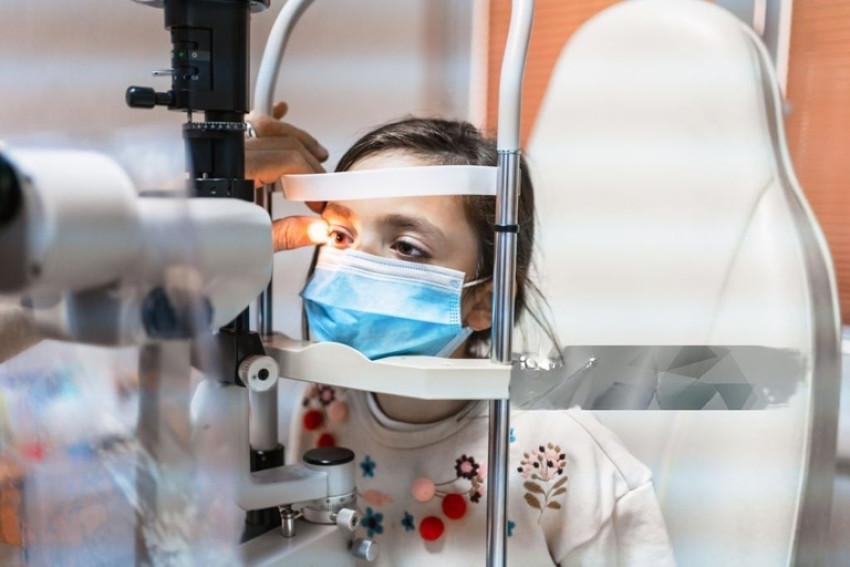
Why and how to protect children's eyes in front of a screen?
From an early age, our children spend more and more time in front of a screen (TV, computer, tablet, smartphone, game console). Many parents wonder if this habit can affect their vision in the long run and if the blue light emitted by these screens carries proven risks.
Can screens cause visual disturbances in our children?
No, the screens do not cause visual disturbances. On the other hand, their intensive use has been associated with the "computer vision syndrome" to use the term used across the Atlantic. It refers to a set of more or less bothersome symptoms: eye fatigue, tingling, dry eyes, headaches, etc.
Note that intensive use of screens can also lead to musculoskeletal disorders with back pain, shoulder pain, neck pain, and even carpal tunnel syndrome or thumb tendinitis for most regular texters.
These symptoms are not specific to children or teenagers, they are also found in adults who work or spend their leisure time in front of all kinds of screens.
From the slightest complaint, preventive measures are essential: position yourself well in front of the screen, take very regular visual breaks (in particular by forcing yourself to look into the distance), position yourself correctly in relation to the outside light in order to limit glare, avoid screens in a room that is too dark, etc. The light atmosphere is crucial, in fact.
Last but not least, according to the experts of God Service Eye Clinic it is important to make sure there is not a convergence problem that has gone unnoticed up until now. It is important to realise that when we are in front of a screen, we use a different visual strategy than when performing other daily tasks.
This may draw attention to a mild convergence disorder that makes eyestrain worse. The correction is then done in collaboration with an orthoptist during visual rehabilitation sessions.
Why is the blue light emitted by screens dangerous?
From a physiological point of view, blue light is everywhere because it is part of the visible spectrum. It is essential for colour balance, "so there is no question of eliminating this wavelength".
On the other hand, during the last decade, lighting using LED bulbs emitting largely in the blue wavelength field has literally imposed itself. They have become ubiquitous in our environment: public lighting (in the streets, hospitals, gymnasiums and all other public places), at work, at home and systematically behind all our screens (TVs, computers, tablets, smartphones, game consoles). games...). In the end, we are much more exposed to blue light than before, both in duration and intensity.
This is why during a cataract operation, which consists of replacing an aged lens with an intraocular lens called an implant, we can offer one associated with an anti-blue light filter, especially in patients at known retinal risk.
However, the effects on our health are not fully defined. Blue light is known to be potentially more toxic to children than to adults, though. In fact, 90 to 80 per cent of blue light can pass through their lens. The amount and intensity of blue light projected onto the retina will not decrease until the ageing lens becomes more adept at absorbing this colour.
Thus, for the same quantity of blue light, the percentage which arrives on the retina differs markedly in children and in adults.
Unknown potential risks
The risks are still poorly known, but they certainly depend on the intensity of blue light, the duration of exposure to this wavelength, and therefore the cumulative dose.
In animals, chemical damage to the eye has been demonstrated following intense exposure. We also know that excess blue light could be a risk factor for age-related macular degeneration (AMD).
Finally, if this blue light is at the origin of our circadian rhythm (day/night), badly, it can conversely cause a disruption of our biological clock and lead to sleep disorders, mood disorders, and even depression. in subjects at risk.
We will remember that we cannot do without blue light, but that better control of our exposure would be beneficial while waiting to learn more about the potential risks of overexposure via lighting and screens.
How can we protect our children's eyes and our own from excessive blue light?
The advice below is common sense:
Limit as much as possible the duration of exposure to screens in childhood and adolescence.
Avoid putting toddlers in front of a screen.
Keep a sufficient distance (take into account the size of the screen and play with the size of the characters).
Decrease the brightness of screens and especially at night, taking into account the ambient light.
Take breaks and all the more so in the event of convergence disorders.
In case of clinical signs, consult an ophthalmologist or an orthoptist.
Do not over add blue light of any kind; be wary of household lights, too often LED, and favour low-light LEDs at home.
Use orange lenses that filter blue light if you work at night on screen or in case of sleep disorders. The goal is to filter more blue light at the end of the day and in the evening.
To lessen glare, wear glasses or screen protectors with blue light-blocking lenses. Ask an optician, because the techniques are changing rapidly and there are now untinted glasses filtering blue-violet light, which can simultaneously correct myopia, hyperopia or astigmatism.





